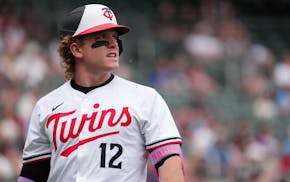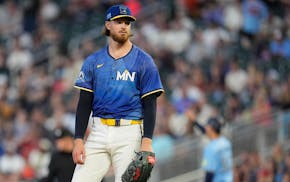FORT MYERS, FLA. – One reason the Twins hired Derek Falvey as their president of baseball operations nearly eight years ago was because of his role in developing Cleveland's pitching pipeline.
The Twins slashed payroll by about $30 million and they had starting pitchers Sonny Gray and Kenta Maeda depart through free agency, so the 2024 season could represent the biggest test for Falvey's efforts to duplicate Cleveland's success.
Starting pitching carried the Twins to an American League Central title last year and their first postseason series win in two decades. Their pitching staff led the league in several important categories. Now comes the hard part — repeating their success with notable subtractions.
"Everyone likes doubters," Twins pitching coach Pete Maki said. "Everyone likes challenges, right? It's motivating to me, our pitching coach staff and for the pitchers, too."
The Twins are optimistic about their incumbent group of starters. Pablo López finished seventh in the AL Cy Young voting last year and looked like an ace in the playoffs. They're bullish about Chris Paddack after he returned from Tommy John surgery. Bailey Ober, Joe Ryan and Louie Varland have flashed potential.
The question hanging over the offseason, though, was how the Twins will replace Gray and Maeda. Their lone addition to the rotation, Anthony DeSclafani, didn't make it out of spring training before an elbow injury flared up.
Gray and Maeda combined to pitch 288⅓ innings with a 3.31 ERA.
"It's a shame they are not going to be here, but that doesn't change our mentality," López said. "They were a part of our philosophy. Now they are with other teams. I know they are going to do great things, but that philosophy stays here. This rotation, this pitching staff ... the goal doesn't change."
Can the Twins replicate one of the best pitching seasons in franchise history after losing two-fifths of their rotation? That's where the philosophy and internal pipeline need to shine. It's how the Guardians, Tampa Bay Rays and Milwaukee Brewers remain consistent despite lower payrolls.
Twins pitchers led the majors in strikeouts (1,560) for the first time in the franchise's history, and they did it while issuing the fourth-fewest walks. It was the first time they led the AL in Ks since 2006, when Johan Santana and Francisco Liriano led the rotation.
"It's hard to lead the league in anything that everyone else is hunting too," Falvey said. "I guarantee you all 30 clubs, they're sitting in there and going, 'How do we get more batters to swing and miss when we're pitching?' That's just part of the game now. To lead in that category was a reflection, I think, of lots of years of good investment in development, good thoughts, good players."
For a long time, the Twins were known as a "pitch to contact" organization. That was one of the constant criticisms. In the six years before Falvey began overseeing the Twins, they finished last in strikeouts five times with zero playoff appearances.
Maki, however, says it's still an important part of their philosophy.
"Good Twins teams pitched to contact," Maki said. "I think we are still a pitch to contact [organization]. We preach that before two strikes. The whole pitch to contact, and wanting misses, and wanting strikeouts, that coexists together for us."
The Twins are proud of how they've developed pitchers, homegrown or otherwise. López took a step forward when he added a sweepy slider last year. Ryan had yet to debut when the Twins traded for him. Ober was a 12th-round draft pick and Varland was a 15th-round selection. Gray, the AL Cy Young Award runner-up last year, and Maeda, the runner-up in 2020, had some of their best seasons after joining the club.
As much as this season will be about whether their initial five starters live up to expectations, the Twins' success may hinge on their next wave of pitching prospects. Simeon Woods Richardson, Brent Headrick and David Festa are next in line, and they've pitched a combined 35 innings in the big leagues.
When the Twins broke camp last year, they had Ober and Varland waiting in the wings. It was important depth when Tyler Mahle underwent elbow surgery early in the season and Maeda had a stint on the injured list.
"The healthiest staffs find a way to replenish internally," Falvey said. "Yeah, you grab some [players] via trade, free agency, whatever it takes, but ultimately, you want to try to build a bit of a pipeline. I think last year was the evolution of we finally got to a place where it felt like everything was clicking in a good way."
A lower payroll entering this year equates to less depth, so that's the immediate challenge. The Twins needed eight starting pitchers to make it through their 162-game schedule last year, but they required 14 in 2022.
The Twins were encouraged by the way their pitching prospects looked in camp. Woods Richardson, the 23-year-old righty acquired in the José Berríos trade, altered his delivery, throwing from a lower arm slot, and it led to better velocity.
"Simeon is light years ahead of where he was last year," Maki said.
Headrick, a lefty, was used as a reliever in his stints in the major leagues last year, but now he's needed as starting depth. Festa is regarded as arguably the top pitching prospect in the organization, though he's made only three starts above Class AA.
"There are always questions coming in every spring about who will be the guys in AAA that we will be turning to when the time comes," Twins manager Rocco Baldelli said. "We have numerous guys that really upped their game coming in. Simeon Woods Richardson looks like a different pitcher. Headrick's velocity ticked up a little bit this spring as well, which I think will be important for him. We have guys that we can look to."
The expectations haven't changed for the Twins. They want to build off their playoff run last year. Their starting pitching depth, which was such a strength, may determine the team's ceiling.
"You know it's a numbers game a little bit," Falvey said. "You know you have a lot of prospects within the group, and you do the best you can to develop all of them. Some get off track, some deal with injury stuff, some end up in the bullpen and some find their way into starting roles. Hopefully, we have enough of that group to help us get through a season."

Twins lose second in a row to Blue Jays as bullpen falters late
What is the 'House settlement,' and what does it mean for the Gophers and NCAA?

Souhan: Anxiety and depression in the NFL helped inspire Lindsey Young's children's book
Neal: Trade season is here ... and now it's time for the Twins to act
